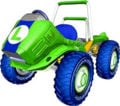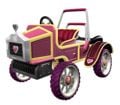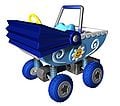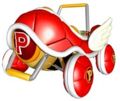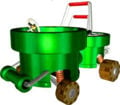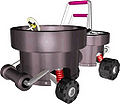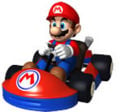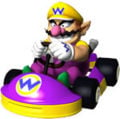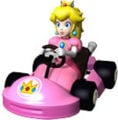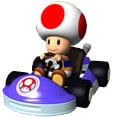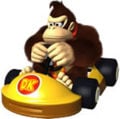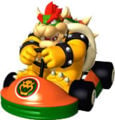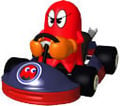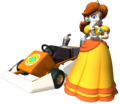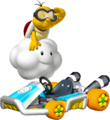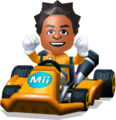Kart
A Kart is a vehicle used in the Mario Kart series. They can come in various sizes and colors, generally regarding to certain character's size and color. The first appearance of the karts was in Super Mario Kart and consequently, they appeared in every Mario Kart game to Mario Kart 7 thus far. The appearance of the karts also changed considerably lately in each racing game, coming out in a variety of shapes and features. A key on every kart lies on its stats. Besides the appearance, each kart is identified by its stats, basically on their size, weight and speed. Thus, this means a character's kart is not essentially the same like the karts of the others.
The Karts also have presented in other game series and media such as in the Super Smash Bros. series, comics, and toys.
History
Mario Kart series
Super Mario Kart
For the first mainstream of the Mario Kart series, Karts appear in Super Mario Kart as simple Go-karts with frames of various colors, regarding to the character driving the vehicle. In game, the concept of "kart" is applied for the Extra Lives of a driver in Grand Prix mode. In case the player's characters lost a race from fifth place or lower, or attempting to retry the race, the character loses one kart (three to start) as a life. Losing all the karts quits the Grand Prix. However, it is possible to regain one life more by placing the same position three times in the row.
- MKMario.PNG
- MKLuigi.PNG
- MKTroopa.PNG
- MKToad.PNG
- MKToadstool.PNG
- MKYoshi.PNG
- MKBowser.PNG
- DKJRMK.PNG
Mario Kart 64
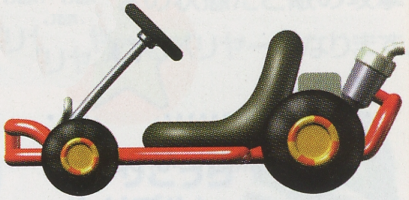
In Mario Kart 64, Karts appear similar to Super Mario Kart, having little changes from the 16 bit game. Both characters and Karts are classified by three classes of weights: light, medium and heavy. Lights are Karts that show a high speed but a fairly low endurance. Medium Karts show all-around traits, whereas Heavy Karts have high endurance but poor speed.
- Red Kart.gif
- Mk64luigi.gif
- Yoshi - Mario Kart 64.png
- Mk64dk.gif
- Mk64bowser.gif
Mario Kart: Super Circuit
Karts shown in Mario Kart: Super Circuit appear the same as in Mario Kart 64. Their traits are similar to the karts shown before, which the vehicle is classified in accordance to its basic stats: Light for the Kart that shows high speed and low weight, Medium for the kart that shows a balanced ratio in speed and weight, and Heavy for the kart with great weight and low speed. In Mario Kart: Super Circuit, the player can press the select button to sound the horn.
- MKLG.PNG
- MKPC.PNG
- MKTD.PNG
- MKYS.PNG
- MKWR.PNG
- MKDK.PNG
- MKBW.PNG
Mario Kart: Double Dash!!
In Mario Kart: Double Dash!!, the basic models of the karts seen from Super Mario Kart to Mario Kart Super Circuit are taken out. For the Mario Kart for the Nintendo GameCube, the karts appear in new models and styles, most of them reflecting some character's special characteristics, such as Mario's kart, the Red Fire, which it is a red and blue-colored all-terrain vehicle, rendering Mario's letter M emblem on its body and wheels. The design of the karts also are changed regarding the new concept "two racers in one vehicle" within the game. The karts have a seat on the front where a character drives the kart and a platform in the rear of the vehicle where the second character is able to use an item taken from the Item Boxes. Just as in Mario Kart: Super Circuit, in Double Dash!! the karts are split in three weight groups: Light, Medium and Heavy. The use of these karts is determined by the characters' weights; therefore, while one of the two characters has a higher weight, characters use a kart within the Medium or Heavy weight class. Pairing both lightweight characters results in a vehicle used as a light kart. The Parade Kart breaks this rule, being usable for any character. The player can press the item button (without the rear character holding an item) to sound the horn, and the rear player makes a small pose.
Every kart has also its own stats. The kart's stats are qualified by the amount of stars on its acceleration, speed and weight. However, these stars can be misleading. In general, lightweight karts have a high acceleration but a fair low speed and endurance. Medium-weight karts have balanced stats, whereas heavyweight karts show a high top speed and endurance, and low acceleration.
Despite that conventional-looking Karts are absent in Mario Kart: Double Dash!!, the Toad Kart and the Toadette Kart greatly resemble a Standard Kart as seen in Mario Kart DS.
There are twenty-one karts in all for this installment.
- BloomCoach.jpg
- Turbobirdo.jpg
- Barreltrain.jpg
- Bulletblaster2.jpg
- Wario car.PNG
Mario Kart Arcade GP sub-series
In Mario Kart Arcade GP all the characters use a standardized model of the kart, appearing with rounded details and a solid building as opposed to many other previous Mario Kart games.
However, in Mario Kart Arcade GP 2 the characters have an option to choose a secondary kart made for them, rather similar to Mario Kart: Double Dash!! and Mario Kart DS.
Just as Mario Kart: Double Dash!!, all the karts are rated out by the amount of the stars for each aspect. Regarding to the character selected, he or she can be light, medium, or heavy, emphasizing one of these aspects for the vehicle available.
Mario Kart Arcade GP
Mario Kart Arcade GP 2
- LuigiGP2.jpg
Luigi's kart - PeachGP2.jpg
Peach's kart - ToadGP2.jpg
Toad's kart - YoshiGP2.jpg
Yoshi's kart - DKGP2.jpg
Donkey Kong's kart - WarioGP2.jpg
Wario's kart - BowserGP2.jpg
Bowser's kart - MsPacManGP2.jpg
Ms. Pac-Man's kart - MametchiGP2.jpg
Mametchi's kart
Mario Kart DS
Unlike what happened in Mario Kart: Double Dash!!, the basic models of the karts reappear in Mario Kart DS, having the name of Standard Karts. These karts are redesigned, having white bumpers and a hood of different color palettes that matches the character's custom color. The decal of the character is shown over the hood, although the player can replace it for his or her own in the emblem maker option. Additionally, every character can select at least one of three vehicles (excluding Shy Guy, having only his Standard Kart SG), exclusive for being rather different in design and stats than the character's Standard Kart. While a Standard Kart has plain stats, the other vehicles can have a high speed, acceleration or items ratio, depending on what the vehicle is made for. Every Kart is qualified by six ratings:
- Acceleration: The time for achieving the top speed. Lightweight karts like Yoshi's Standard Kart YS have the highest acceleration rating.
- Speed: The top speed level when a kart moves forwards. Most of the karts within the heavyweight class show the highest speed rating.
- Weight: The kart's endurance. When a kart has a higher weight, it is capable of knocking apart light karts.
- Drifting: The friction power of the kart when turns by powersliding. A high drifting rate makes the kart turn tighter.
- Handling: The control over the vehicle in all type of terrains. The power of the Mini-Turbo caused by drifting also depends how high the kart's handling is.
- Items: The variety of items to obtain in an Item Box. As the kart's item stat is high, the character can receive more rare items to use. The smaller the kart's wheels, the lower the meter is for the Items stat.
- MKDS-Mario Artwork.png
Mario
Standard Kart MR - MKDS-Luigi Artwork.png
Luigi
Standard Kart LG - MKDS-Peach Artwork.png
Peach
Standard Kart PC - MKDS-Yoshi Artwork.png
Yoshi
Standard Kart YS - MKDS-Toad Artwork.png
Toad
Standard Kart TD - MKDS-Donkey Kong Artwork.png
Donkey Kong
Standard Kart DK - MKDS-Wario Artwork.png
Wario
Standard Kart WR - MKDS-Bowser Artwork.png
Bowser
Standard Kart BW Daisy
Standard Kart DS- MKDS-Dry Bones Artwork.png
Dry Bones
Standard Kart DB - MKDS-Waluigi Artwork.png
Waluigi
Standard Kart WL - MKDS-ROB Artwork.png
R.O.B.
Standard Kart RB - Shy Guy - MKDS.png
Shy Guy
Standard Kart SG
Mario Kart Wii
The Karts in Mario Kart Wii are once again redesigned with various details added than they appeared formerly. Similar to Mario Kart DS, the typical go-karts receive the name of Standard Karts, and are classified according to the size of the vehicle, split in three groups: Standard Kart S for small-sized characters; Standard Kart M for medium size characters and Standard Kart L for large characters. Albeit weight classes are replaced for size classes, the general aspects of the karts are the same as appeared throughout the series.
- Speed: The level of the top speed.
- Weight: The strength of the vehicle to knock apart others.
- Acceleration: The time to achieve the top speed.
- Handling: The control of the vehicle.
- Drift: The friction power of the vehicle.
- Off-road: The speed of the vehicle over rough terrain.
- Mini-turbo: The power of the momentary speed burst after drifting or made a trick.
In addition, each racer can vary the kart's custom stats with the bonus points he or she has for each feature and select other five karts in the determined character's size.
Unlike their two-wheeled counterparts Bikes, Karts cannot perform wheelies. However, they can release a more powerful mini-turbo by drifting than a bike, depending how long the respective button is pressed.
Mario
MediumLuigi
Medium- Peachbasic.PNG
Peach
Medium - Yoshibasic.PNG
Yoshi
Medium - Babymariobasic.PNG
Baby Mario
Small - Babypeachbasic.PNG
Baby Peach
Small Toad
Small- KoopaBasic.PNG
Koopa Troopa
Small - Wariobasic.PNG
Wario
Large - Waluigibasic.PNG
Waluigi
Large - Dkbasic.PNG
Donkey Kong
Large Bowser
Large- DaisyMKWii.PNG
Daisy
Medium - Birdomkwii.PNG
Birdo
Medium - Diddymkwii.PNG
Diddy Kong
Medium - Jrwii.PNG
Bowser Jr.
Medium - Babyluigi.PNG
Baby Luigi
Small - Babydaisykart.PNG
Baby Daisy
Small - Toadettewii.PNG
Toadette
Small - Drybwii.PNG
Dry Bones
Small - Boowiiking.PNG
King Boo
Large - Rosawii.PNG
Rosalina
Large - Funkpngmm.PNG
Funky Kong
Large - Skelebowwii.PNG
Dry Bowser
Large
Stats
Standard Kart S
| Speed | 41/80
|
| Weight | 29/80
|
| Acceleration | 48/80
|
| Handling | 48/80
|
| Drift | 51/80
|
| Off-Road | 40/80
|
| Mini-Turbo | 45/80
|
| Drift-type | Out |
Standard Kart M
| Speed | 46/80
|
| Weight | 45/80
|
| Acceleration | 40/80
|
| Handling | 43/80
|
| Drift | 45/80
|
| Off-Road | 35/80
|
| Mini-Turbo | 40/80
|
| Drift-type | Out |
Standard Kart L
| Speed | 48/80
|
| Weight | 59/80
|
| Acceleration | 37/80
|
| Handling | 40/80
|
| Drift | 40/80
|
| Off-Road | 35/80
|
| Mini-Turbo | 35/80
|
| Drift-type | Out |
Mario Kart 7
Karts make their most recent appearance in Mario Kart 7 for the Nintendo 3DS, having a design similar to the ones from Mario Kart DS and Mario Kart Wii. They are seen to have some new additions: they deploy gliders if a character is propelled in the air from a high place to help them glide, and when underwater, a propeller will appear at the back to help push the kart along. Players are able to customize their karts as well. Some Karts from previous installments also return in the game.
The Standard kart is the default kart body that players can choose. It offers no stat boosts in any way, but players can change the wheels and gliders to control its stats. There is also the Gold Standard, which appears as an unlockable part. The original kart from Super Mario Kart to Mario Kart: Super Circuit reappears in Mario Kart 7, known as the Pipe Frame. As opposed to the standard, the Pipe Frame slightly changes stats, it's much wider than the past, and has the player's emblem on the back.
Pipe Frame
The Pipe Frame is an unlockable body. It can be unlocked by obtaining a random number of coins (from 50 to 4500). This was the Standard Kart in the first three Mario Kart games. Unlike the Standard body, the Pipe Frame body slightly alters stats. It gives a slight acceleration and off-road boost, while giving up a bit of speed and weight in the process. Like the Standard, it has a different color scheme for each character.
Color Schemes
- Mario - Red
- Luigi - Green
- Peach - Pink
- Yoshi - Light Green
- Bowser - Orange
- Donkey Kong - Yellow
- Toad - Blue
- Koopa - Light Yellow
- Daisy - Yellow-Orange
- Wario - Purple
- Rosalina - Turquoise
- Metal Mario - Silver
- Shy Guy - Black
- Honey Queen - Magenta
- Wiggler - Brown
- Lakitu - Sky Blue
- Mii - Color depends on Mii's color
Gold Standard
The Gold Standard (also known in Europe and Australia as Gold Kart) is another unlockable body. It can be earned by collecting 20000 coins, or by earning 10000 VR in Wi-Fi races. Just like the Pipe Frame, it slightly alters stats, but mirrored.
When the Gold Standard body is combined with the Gold Tires and Gold Glider, they complete the whole Gold Standard. This kart gives great speed (the 2nd biggest boost in the game) and good weight, but has a negative handling boost, and abysmal off-road (the worst boost in the game).
Stat Boosts
|
|
|
|
Names in other languages
| Standard | Pipe Frame | Gold Standard |
Mario Kart 8
The standard Kart is set to appear in the upcoming Mario Kart 8. They have a similar appearance to the Standards from Mario Kart 7, but this time they have a new addition for the anti-gravity, the wheels will go horizontal. Like in Mario Kart 7, the players will be able to choose the bodies, wheels, and gliders their karts.
In the upcoming Mario Kart 8, the player can press the player icon on the Wii U Gamepad to sound the horn.
Club Nintendo
"Die Jagd nach dem Nintendo 64: Krawall im All"
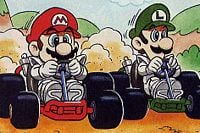
In the Club Nintendo comic "Die Jagd nach dem Nintendo 64: Krawall im All", Mario and Luigi are seen driving karts in their mission to find a spaceship shaped like the Nintendo 64. They compete against Wario and Bowser and make another reference to the Mario Kart games by dropping Banana Peels and making them crash. The karts seen in this comic resemble those seen in the then-new Mario Kart 64. Unlike their video game equivalents, though, they can also be turned into jet skis by pushing a button on their steering-wheels.
Mario Kirby Meisaku Video
A Kart makes an apperance resembling the one in Super Mario Kart in the Mario segment of the Mario Kirby Meisaku Video where Mario drives it during his pursuit of the mysterious thief W. Eventually, after being attacked by some monsters, he spins out near a vegetable garden.
Super Smash Bros. series
Super Smash Bros. Melee Trophy
| Name | Image | Game | Description |
|---|---|---|---|
| Racing Kart | File:Trophy213.PNG | Super Mario Kart 9/92 |
The famous racing karts from the ever-popular Mario Kart racing series come loaded for spee with three different engine sizes: 50, 100, and 150 cc. The karts' handling differs with the characters driving them, but all of them utilize Mario Kart standards like drift, jump, and turbo. They're extremely durable and impossible to total. |
Super Smash Bros. Brawl
The Karts make a brief appearance in Super Smash Bros. Brawl. Unlike in Melee, where they appear as trophies, they are obstacles for the Mario Circuit battle stage. All the karts are as seen in Mario Kart DS, driven by red Shy Guys competing a race, while characters carry out their battle there. The karts tend to pass in the road where contestants fight, dealing damage to anybody who makes contact with them. Characters can use their moves against karts to send them flying away. Unlike how they looked in Mario Kart DS, Karts come in various colors, and their bumpers and emblems are colored differently as well.
Trivia
- The Kart appears in Nintendo Monopoly under the name "Mario Kart", where it replaces Reading Railroad as a purchasable vehicle. It costs $200. There is also a Coin Block/Brick Block card that charges the player $150 for renewing their Kart license in the 2006 version, and only $50 in the 2010 version. The ? Block card in both versions allows the player to take a spin in the kart, which advances them to the Mario Kart space along with a $200 passing Go bonus.
- In the DS game Nintendogs, it is possible to find Mario, Peach, and Bowser Karts from Mario Kart DS which play the Mario Circuit, Peach Beach, and Bowser's Castle music from Mario Kart: Double Dash!!, respectively, when used.
- Mario and Peach Karts also return in the 3DS game Nintendogs + Cats while Yoshi Kart replaces Bowser Kart. When used, Mario, Peach and Yoshi karts play Mario Circuit, DS Peach Gardens, and DS Yoshi Falls music from Mario Kart Wii respectively.
- In Mario Kart 7 the Gold Standard's steering wheel is gold, but in first person view, it is black, unless the player has earned the Golden Steering Wheel.





